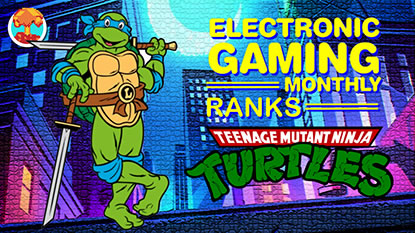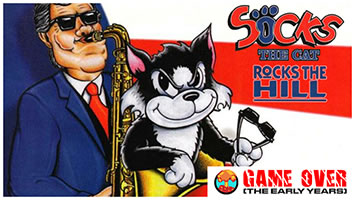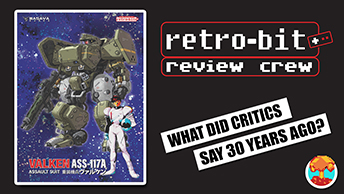- CLASSIC MAGAZINES
- REVIEW CREW
A show recapping what critics thought back
when classic games first came out! - NEXT GENERATION'S BEST & WORST
From the worst 1-star reviews to the best
5-stars can offer, this is Next Generation! - NINTENDO POWER (ARCHIVE)
Experience a variety of shows looking at the
often baffling history of Nintendo Power! - MAGAZINE RETROSPECTIVE
We're looking at the absolutely true history of
some of the most iconic game magazines ever! - SUPER PLAY'S TOP 600
The longest and most ambitious Super NES
countdown on the internet! - THEY SAID WHAT?
Debunking predictions and gossip found
in classic video game magazines! - NEXT GENERATION UNCOVERED
Cyril is back in this spin-off series, featuring the
cover critic review the art of Next Generation! - HARDCORE GAMER MAGAZING (PDF ISSUES)
Download all 36 issues of Hardcore Gamer
Magazine and relive the fun in PDF form!
- REVIEW CREW
- ELECTRONIC GAMING MONTHLY
- ELECTRONIC GAMING MONTHLY RANKS
From Mario to Sonic to Street Fighter, EGM
ranks classic game franchises and consoles! - ELECTRONIC GAMING MONTHLY BEST & WORST
Counting down EGM’s best and worst reviews
going year by year, from 1989 – 2009! - ELECTRONIC GAMING BEST & WORST AWARDS
11-part video series chronicling the ups and
downs of EGM’s Best & Worst Awards!
- ELECTRONIC GAMING MONTHLY RANKS
- GAME HISTORY
- GAME OVER: STORY BREAKDOWNS
Long-running series breaking down game
stories and analyzing their endings! - A BRIEF HISTORY OF GAMING w/ [NAME HERE]
Real history presented in a fun and pithy
format from a variety of game historians! - THE BLACK SHEEP
A series looking back at the black sheep
entries in popular game franchises! - INSTANT EXPERT
Everything you could possibly want to know
about a wide variety of gaming topics! - FREEZE FRAME
When something familiar happens in the games
industry, we're there to take a picture! - I'VE GOT YOUR NUMBER
Learn real video game history through a series
of number-themed episodes, starting at zero! - GREAT MOMENTS IN BAD ACTING
A joyous celebration of some of gaming's
absolute worst voice acting!
- GAME OVER: STORY BREAKDOWNS
- POPULAR SHOWS
- DG NEWS w/ LORNE RISELEY
Newsman Lorne Riseley hosts a regular
series looking at the hottest gaming news! - REVIEW REWIND
Cyril replays a game he reviewed 10+ years
ago to see if he got it right or wrong! - ON-RUNNING FEUDS
Defunct Games' longest-running show, with
editorials, observations and other fun oddities! - DEFUNCT GAMES QUIZ (ARCHIVE)
From online quizzes to game shows, we're
putting your video game knowledge to the test!- QUIZ: ONLINE PASS
Take a weekly quiz to see how well you know
the news and current gaming events! - QUIZ: KNOW THE GAME
One-on-one quiz show where contestants
find out if they actually know classic games! - QUIZ: THE LEADERBOARD
Can you guess the game based on the classic
review? Find out with The Leaderboard!
- QUIZ: ONLINE PASS
- DEFUNCT GAMES VS.
Cyril and the Defunct Games staff isn't afraid
to choose their favorite games and more! - CYRIL READS WORLDS OF POWER
Defunct Games recreates classic game
novelizations through the audio book format!
- DG NEWS w/ LORNE RISELEY
- COMEDY
- GAME EXPECTANCY
How long will your favorite hero live? We crunch
the numbers in this series about dying! - VIDEO GAME ADVICE
Famous game characters answer real personal
advice questions with a humorous slant! - FAKE GAMES: GUERILLA SCRAPBOOK
A long-running series about fake games and
the people who love them (covers included)! - WORST GAME EVER
A contest that attempts to create the worst
video game ever made, complete with covers! - LEVEL 1 STORIES
Literature based on the first stages of some
of your favorite classic video games! - THE COVER CRITIC
One of Defunct Games' earliest shows, Cover
Critic digs up some of the worst box art ever! - COMMERCIAL BREAK
Take a trip through some of the best and
worst video game advertisements of all time! - COMIC BOOK MODS
You've never seen comics like this before.
A curious mix of rewritten video game comics!
- GAME EXPECTANCY
- SERIES ARCHIVE
- NINTENDO SWITCH ONLINE ARCHIVE
A regularly-updated list of every Nintendo
Switch Online release, plus links to review! - PLAYSTATION PLUS CLASSIC ARCHIVE
A comprehensive list of every PlayStation
Plus classic release, including links! - RETRO-BIT PUBLISHING ARCHIVE
A regularly-updated list of every Retro-Bit
game released! - REVIEW MARATHONS w/ ADAM WALLACE
Join critic Adam Wallace as he takes us on a
classic review marathon with different themes!- DEFUNCT GAMES GOLF CLUB
Adam Wallace takes to the links to slice his way
through 72 classic golf game reviews! - 007 IN PIXELS
Adam Wallace takes on the world's greatest spy
as he reviews 15 weeks of James Bond games! - A SALUTE TO VAMPIRES
Adam Wallace is sinking his teeth into a series
covering Castlevania, BloodRayne and more! - CAPCOM'S CURSE
Adam Wallace is celebrating 13 days of Halloween
with a line-up of Capcom's scariest games! - THE FALL OF SUPERMAN
Adam Wallace is a man of steel for playing
some of the absolute worst Superman games! - THE 31 GAMES OF HALLOWEEN
Adam Wallace spends every day of October afraid
as he reviews some of the scariest games ever! - 12 WEEKS OF STAR TREK
Adam Wallace boldly goes where no critic has
gone before in this Star Trek marathon!
- DEFUNCT GAMES GOLF CLUB
- DAYS OF CHRISTMAS (ARCHIVE)
Annual holiday series with themed-episodes
that date all the way back to 2001!- 2015: 30 Ridiculous Retro Rumors
- 2014: 29 Magazines of Christmas
- 2013: 29 Questionable Power-Ups of Christmas
- 2012: 34 Theme Songs of Christmas
- 2011: 32 Game Endings of Christmas
- 2010: 31 Bonus Levels of Christmas
- 2009: 30 Genres of Christmas
- 2008: 29 Controls of Christmas
- 2007: 34 Cliches of Christmas
- 2006: 33 Consoles of Christmas
- 2005: 32 Articles of Christmas
- 2004: 31 Websites of Christmas
- 2003: 29 Issues of Christmas
- 2002: 28 Years of Christmas
- 2001: 33 Days of Christmas
- NINTENDO SWITCH ONLINE ARCHIVE
- REVIEW ARCHIVE
- FULL ARCHIVE
Five Exciting Facts About Rolling Thunder
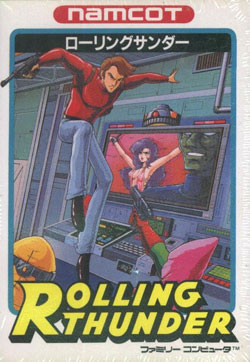
Rolling Thunder (Famicom)
Welcome to Instant Expert, the show that teaches you everything you might possibly need to know about an old game series. Now you can look smart as you impress your friends with obscure trivia and your strong grasp on rare and obscure releases. With Instant Expert you will never be the loser at the office gathering that doesn't know the finer details of a game franchise nobody's heard of. We guarantee that you'll be the life of the party or we'll give you a full refund!
SERIES: Rolling Thunder (1986 - 1993)
GAMOGRAPHY: Namco released three games over the course of seven years. The original arcade game was released in 1986, shortly followed by a port for the Nintendo Entertainment System. Rolling Thunder 2 hit arcades in 1990 and then later ported to the Sega Genesis. Rolling Thunder 3 is a console-exclusive, released in 1993 for the Genesis.
THE BASICS: Rolling Thunder is the story of a spy with an incredible set of legs. He and his World Crime Police Organization cohorts fights an alien/terrorist group known as Geldra, which takes them all over the world and even into space. Eventually we learn that Gelda is interested in taking over the world using robots, but our heroes at the World Crime Police Organization aren't going to let that happen!
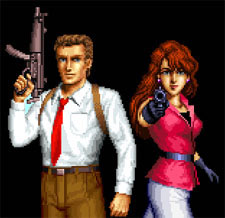 are tasked with saving the world from an alien madman commanding an army of robots. Okay, so it's not exactly Aliens Resurrected, but it's a lot more science fiction than Moonraker.
are tasked with saving the world from an alien madman commanding an army of robots. Okay, so it's not exactly Aliens Resurrected, but it's a lot more science fiction than Moonraker.
Don't think the first game is full of sci-fi goodness? Well, you're mostly right. It's a game about saving your girlfriend from a group of hooded men. But at least there's Maboo, who throws fireballs and is green. This villain was fleshed out a bit more in Rolling Thunder 2, which featured Albatross and Leila tracking down a new mastermind named Gimdo. It turns out that Gimdo is part of the alien/terrorist network known as Geldra, and he is hoping to use his spaceship to sabotage a satellite and reign nuclear bombs on the Earth below. The third Rolling Thunder features a new character battling more robots than even Skynet is comfortable with. We never find out where these villains come from, but it's certainly not of this planet.
One year later Sega released a game with almost exactly the same gameplay mechanic. While Joe Musashi may not find extra bullets in closets, he is able to leap to building tops and other high up locations. In 1990, Capcom released Code Name: Viper, a game so blatant in its homage that I would go as far as to call it a rip-off. You leap ten feet off the ground, battle on two layers, and find ammo/safety in doors. Both of these games have their own spin on the formula, but there's no denying that they were influenced by Namco's Rolling Thunder!
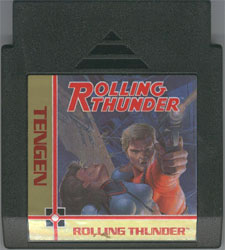 may remember the Tengen port, sporting the all too familiar black box and dazzling box art. Despite being developed by Namco (one of Nintendo's strongest first-party games), this Tengen release was not officially endorsed by Nintendo and lacked the seal of quality.
may remember the Tengen port, sporting the all too familiar black box and dazzling box art. Despite being developed by Namco (one of Nintendo's strongest first-party games), this Tengen release was not officially endorsed by Nintendo and lacked the seal of quality.
On the other side of the world, Japanese gamers were able to play a Nintendo-approved version of Rolling Thunder. The gameplay and visuals were the same, but for whatever reason Nintendo decided to endorse one and doom the other to obscurity. Thankfully Nintendo's plan of burying the competition didn't work and retailers across the country continued to stock Tengen games. Still, it's an interesting twist of fate that one game can be fully sanctioned by Nintendo, yet the other is denied to the party. Either way, the 8-bit Nintendo Entertainment System port of Rolling Thunder is definitely worth your time.
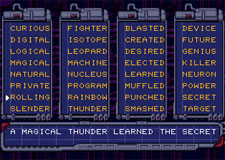 over again. Thank goodness we'll never have to go back to a day where one missed digit requires you to enter the full code all over again. I get enough of that trying to redeem Xbox Live Arcade games.
over again. Thank goodness we'll never have to go back to a day where one missed digit requires you to enter the full code all over again. I get enough of that trying to redeem Xbox Live Arcade games.
But Rolling Thunder 2 made passwords fun. Instead of using arbitrary letters and numbers, Namco devised an ingenious secret message that perfectly fit the game's spy motif. You picked from a series of words to create such gems as "A Rolling Program Smashed The Genius," "A Curious Rainbow Learned the Future, "A Logical Thunder Smashed the Powder," and my favorite, "A Digital Rainbow Muffled the Secret." Oh sure, you still have to cycle through several columns of words to compose your password, but the codes are memorable and don't feel out of place with the rest of the game.
With Albatross and Leila out of the picture, Namco needed a brand new hero for Rolling Thunder 3. Unfortunately they went with Jay, a brand new agent off on his own adventure. Taking place concurrently with the events of Rolling Thunder 2, Jay's adventure has him tracking down Dread, Geldra's second in command. Even though he eventually battles and kills the terrorist madman, Dread has one final card up his sleeve: A self-destructing bomb that gets trickered the moment his heart stops beating. And with no time to escape, Jay and the rest of the evil HQ is blown up. The game reassures us that his charred remains were never found, but that's little comfort with no follow-up sequels or fiction. At least Albatross and Leila live happily ever after.
SERIES: Rolling Thunder (1986 - 1993)
GAMOGRAPHY: Namco released three games over the course of seven years. The original arcade game was released in 1986, shortly followed by a port for the Nintendo Entertainment System. Rolling Thunder 2 hit arcades in 1990 and then later ported to the Sega Genesis. Rolling Thunder 3 is a console-exclusive, released in 1993 for the Genesis.
THE BASICS: Rolling Thunder is the story of a spy with an incredible set of legs. He and his World Crime Police Organization cohorts fights an alien/terrorist group known as Geldra, which takes them all over the world and even into space. Eventually we learn that Gelda is interested in taking over the world using robots, but our heroes at the World Crime Police Organization aren't going to let that happen!
It's Really a Science Fiction Game
You may not spend your time traveling from planet to planet like Mass Effect or battling religious aliens creatures like Halo, but Rolling Thunder is a science fiction game through and through. These three super spies

Don't think the first game is full of sci-fi goodness? Well, you're mostly right. It's a game about saving your girlfriend from a group of hooded men. But at least there's Maboo, who throws fireballs and is green. This villain was fleshed out a bit more in Rolling Thunder 2, which featured Albatross and Leila tracking down a new mastermind named Gimdo. It turns out that Gimdo is part of the alien/terrorist network known as Geldra, and he is hoping to use his spaceship to sabotage a satellite and reign nuclear bombs on the Earth below. The third Rolling Thunder features a new character battling more robots than even Skynet is comfortable with. We never find out where these villains come from, but it's certainly not of this planet.
It Influenced Sega and Capcom
What could have been just another throwaway 8-bit action game turned into something far more memorable thanks to an inventive gameplay gimmick. Albatross is not only a superspy with a smoking hot (albeit kidnapped) partner, but he has an almost superhuman ability to jump from one story to the next. This is the defining aspect of Rolling Thunder, the ability to literally jump to another part of a stage, which must be at least nine or ten feet off the ground. On top of this, our hero is able to hide and find extra bullets in doors scattered around the levels.One year later Sega released a game with almost exactly the same gameplay mechanic. While Joe Musashi may not find extra bullets in closets, he is able to leap to building tops and other high up locations. In 1990, Capcom released Code Name: Viper, a game so blatant in its homage that I would go as far as to call it a rip-off. You leap ten feet off the ground, battle on two layers, and find ammo/safety in doors. Both of these games have their own spin on the formula, but there's no denying that they were influenced by Namco's Rolling Thunder!
The Seal of Quality Conundrum
Did the console port of Rolling Thunder carry Nintendo's seal of quality? It turns out the answer isn't as easy as yes or no. That's because Namco's action game was licensed in one part of the worlds, and unlicensed everywhere else. American gamers

On the other side of the world, Japanese gamers were able to play a Nintendo-approved version of Rolling Thunder. The gameplay and visuals were the same, but for whatever reason Nintendo decided to endorse one and doom the other to obscurity. Thankfully Nintendo's plan of burying the competition didn't work and retailers across the country continued to stock Tengen games. Still, it's an interesting twist of fate that one game can be fully sanctioned by Nintendo, yet the other is denied to the party. Either way, the 8-bit Nintendo Entertainment System port of Rolling Thunder is definitely worth your time.
The Greatest Password System!
Of all the antiquated mechanics found in classic games, the password system is one of the most abhorrent. I still have nightmares of writing down twenty and thirty character long passwords, and then suffering through using the D-pad to type it all

But Rolling Thunder 2 made passwords fun. Instead of using arbitrary letters and numbers, Namco devised an ingenious secret message that perfectly fit the game's spy motif. You picked from a series of words to create such gems as "A Rolling Program Smashed The Genius," "A Curious Rainbow Learned the Future, "A Logical Thunder Smashed the Powder," and my favorite, "A Digital Rainbow Muffled the Secret." Oh sure, you still have to cycle through several columns of words to compose your password, but the codes are memorable and don't feel out of place with the rest of the game.
The Hero Dies in the End
Spoiler Alert: Not everything works out for our hero at the end of Rolling Thunder 3. For those not keeping track, the first Rolling Thunder was about Agent Albatross trying to rescue a female spy. In Rolling Thunder 2, Albatross and Leila go after a green-faced terrorist. They travel all around the world until finally besting Geldra. With their storyline completed, the couple decide to leave the super-secret team and spend the rest of their lives bouncing from one romantic location to the next. It's adorable.With Albatross and Leila out of the picture, Namco needed a brand new hero for Rolling Thunder 3. Unfortunately they went with Jay, a brand new agent off on his own adventure. Taking place concurrently with the events of Rolling Thunder 2, Jay's adventure has him tracking down Dread, Geldra's second in command. Even though he eventually battles and kills the terrorist madman, Dread has one final card up his sleeve: A self-destructing bomb that gets trickered the moment his heart stops beating. And with no time to escape, Jay and the rest of the evil HQ is blown up. The game reassures us that his charred remains were never found, but that's little comfort with no follow-up sequels or fiction. At least Albatross and Leila live happily ever after.

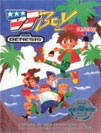
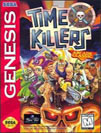
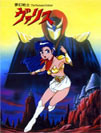
HOME |
CONTACT |
NOW HIRING |
WHAT IS DEFUNCT GAMES? |
NINTENDO SWITCH ONLINE |
RETRO-BIT PUBLISHING
Retro-Bit |
Switch Planet |
The Halcyon Show |
Same Name, Different Game |
Dragnix |
Press the Buttons
Game Zone Online | Hardcore Gamer | The Dreamcast Junkyard | Video Game Blogger
Dr Strife | Games For Lunch | Mondo Cool Cast | Boxed Pixels | Sega CD Universe | Gaming Trend
Game Zone Online | Hardcore Gamer | The Dreamcast Junkyard | Video Game Blogger
Dr Strife | Games For Lunch | Mondo Cool Cast | Boxed Pixels | Sega CD Universe | Gaming Trend
Copyright © 2001-2025 Defunct Games
All rights reserved. All trademarks are properties of their respective owners.
All rights reserved. All trademarks are properties of their respective owners.













